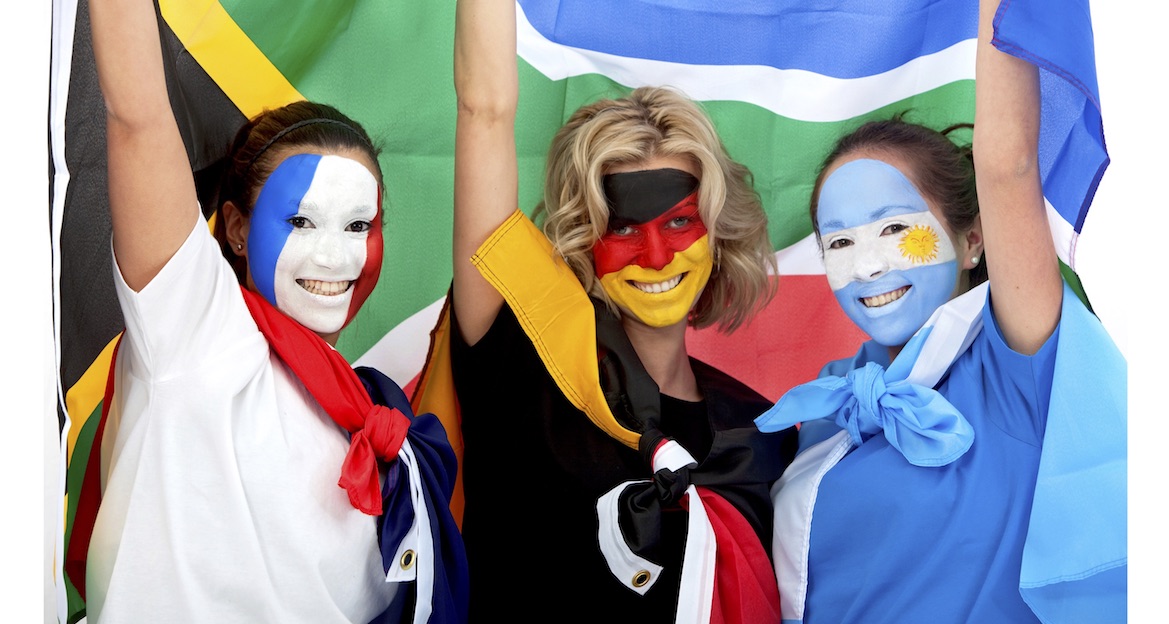
⚽️A Comprehensive Beginners Guide to the 2018 FIFA World Cup
The United States finally got a burst of good news in a year of darkness as the US, Canada and Mexico were collectively awarded the 2026 World Cup tournament. Many American soccer fans would love to fast forward to the next decade when they will not only play hosts but have their first shot at reentering the world’s most prestigious sporting event after failing to qualify for the first time since 1986.
Interest in this year’s version will likely be down in the States, but the absence of the Americans offers otherwise neutral fans a unique opportunity. Those not anxiously tethered to a another country’s hopes can sit back, relax and take in this grandiose event without hyperventilating and chewing off our fingernails.
For the newbies to soccers, myself included, not having to use all that brain space on quickly learning all the relevant American players and related storylines, means we can seize this opportunity to appreciate the sport. The key players, the history, the rules the overwhelming importance to rest of the world. With that sentiment, here is a primer to get you ready for all the action, starting with putting a painful year to rest…
Why exactly isn’t the US in it again?
The US has participated in every World Cup since 1990, until their ignominious failure to qualify in 2018. While considered an average team at best, the US typically benefits from playing in a region, the Confederation of North, Central America and Caribbean Association Football (“CONCACAF”) that is relatively weak compared to others (for example, Europe or South America).
Going into the last qualifying game, the US sat comfortably in third place (four teams qualify) behind Mexico and Costa Rica, the other two usual qualifiers in the region. However, three unlikely events occurred in that last day. The US lost 2-1 to Trinidad and Tobago (with the help of an own goal), the worst team in the group, while Honduras beat Mexico and Panama beat Costa Rica. This allowed both Honduras and Panama to slip ahead of the US by a single point, leaving the US in fifth position and out of the running.
What is the World Cup format?
There are thirty-two teams, organized into eight groups of four. The group stage is played in round-robin format, and two teams from each group will advance to the elimination round according to an aggregate point system (3 points for win, 1 point for tie). There are no ties in the elimination round, as matches will be decided by penalty kicks if there remains a tie after overtime.
What are the basic strategies?
Compared with the other “football,” soccer thrives on in-the-moment spontaneity with minimal advance planning. Still, there are variations in strategy that teams will employ. It begins with the formation. The most common formation in modern soccer is a 4-4-2, meaning four defensemen, four midfielders, and two strikers. But more defensively-minded teams will employ a 4-5-1 while more offensively-minded teams use a 4-3-3. The more nimble coaches will adjust their formation to their players’ relatively skill sets.
Beyond the formation, teams will vary on the degree to which they press the action in the midfield. Typically, the more skilled teams do this—i.e., the ones who are confident at controlling the ball in tight quarters and making pinpoint passes—while the lesser skilled teams may be more inclined to sit back on defense and exploit opportunities for counter-attack.
Finally, World Cup soccer is generally lower quality than high-level club soccer (for example, the English Premier League). Even though the individual talent is higher, overall play suffers from the lack of familiarity and heightened pressure. This often results in lower scoring games, as World Cup teams are more inclined to play conservatively to avoid opening up the field for a counter-attack.
Why are soccer players constantly feigning injury?
I really don’t know. It’s super-annoying and gives the sport a bad name.
What do the penalty cards mean?
There are two kinds of penalty cards, yellow and red. Both can be distinguished from a common foul, which is awarded with a simple free kick where the foul is committed.
Like the color implies, a yellow card is an official caution for a particularly reckless play. If a player gets a second yellow card in a game he is ejected, and his team cannot insert a substitute (i.e., they have to play with 10 players).
A red card is an immediate objection. It is only given out for violent conduct or illegal and purposeful obstruction of a goal scoring opportunity for the opposing team.
What is offsides?
Offsides occurs when an offensive player who is actively involved in a play is nearer to the opponent’s goal than both the ball and the second to last opponent (i.e., everyone but the goalie). It is one of the most controversial calls in the game because it requires split-second assessment by the line judge and defenses often run a so-called “offside trap,” where they intentionally run away from their goal in order to trap the offensive player offsides.
How can I REALLY be invested in the World Cup?
Have some skin in the game. Fill out a bracket and start a pool. You will learn so much by osmosis.
Why is the 2018 World Cup in Russia?
Russia was selected by Federation Internationale de Football Association (FIFA) as host for the 2018 World Cup in December of 2010, beating out three other bidders (Spain-Portugal Holland-Belgium, and England). Russia’s selection was made at the same time as Qatar was selected as host for the 2022 World Cup. At the time, FIFA had explained its philosophy to develop soccer worldwide, “especially in those regions of the world where that development is needed.” But since then, FIFA has been plagued with allegations of corruption, which may have tainted the selection process.
Where in Russia is the World Cup played?
Russia is a large country. There are eleven different host cites spread out over 1,800 miles, from Kaliningrad in the West, to St. Petersburg in the North, to Ekaterinburg in the East, to Sochi in the South. Not surprisingly, the opening match, semi-final, and final will all be played at Luzhniki Stadium in Moscow. Putin will be there, and the question on everyone’s mind is whether he will pull a Brandi Chastain and go shirtless.
What are some key rivalries?
Brazil vs. Argentina: Continental neighbors with storied histories and legendary players, Pele, Maradona, Neymar, Messi. They squared off several times in the 1970s through 1990s, including the infamous “holy water” game, where Argentina alleged spike Brazil’s water with tranquilizers. But they haven’t met in a World Cup recently.
Germany vs. Brazil: These are the dynasties, soccer’s equivalent to the Patriots and well, the Patriots. Brazil has the most World Cups (5), with Germany second (4). The Brazilians are hoping to avenge for an embarrassing 7-1 loss to the Germans in the 2014 semis.
Poland vs. Russia: This one is rooted in politics, not soccer ability. Poland was under the Eastern Bloc until the USSR dissolved in 1989 and continued to be distrustful of the Russians in the aftermath. Both countries are known for extreme hooligans among their football fans. In fact, over a 100 clashing fans were arrested the last time these two faced off, a 1-1 draw in the 2012 Euro Cup.
There are several other geopolitical rivalries among the field of 32 including Serbia and Croatia (past civil war) and Iran and Saudi Arabia (on brink of civil war)
Who are the players I need to know?
Lionel Messi (Argentina): The Barcelona star forward, who has tied for a record five Ballon d’Ors (awarded to the top player) may be the greatest footballer to ever play. But Messi is missing one thing from his expansive trophy case – a World Cup. In fact, he’s never scored in the knockout round. This may be his last chance.
Mohamed Salah (Egypt): Unlike Messi and other stars in this World Cup, Salah has seemingly come out of nowhere to become an elite player, first with Roma and now with Liverpool. Last season Salah scored 32 goals, breaking the Premier League’s single-season scoring record. Salah injured his shoulder in the Champions League final and while he is slated to play for Egypt in their first World Cup in 28 years, fans are shuttering with fear about possible limitations.
Cristiano Ronaldo (Portugal): The 33-year-old megastar’s 81 goals is more than any active player in international play. Like Messi, Ronaldo has won five Ballon d’Or Awards, including in 2017, but is hoping to improve on Portugal’s best finish, the semi-finals in 2006. No player exhibits more grit and lightening footwork.
Neymar (Brazil): Following in the tradition of one-named wonders like Pele and Ronaldo, Neymar is the latest star to aid Brazil to top contender status. A textbook prodigy, Neymar made his professional debut at age 17 and won multiple Player of the Year Awards by age 21. He was injured in the 2014 World Cup prior to Brazil’s humiliating semifinal defeat to Germany. This go around Ronaldo calls Neymar Brazil’s “greatest hope” for winning the tournament for the first time since 2002.
Manuel Neuer (Germany): Neuer is arguable to best goalkeeper in the world and his gatekeeping will be key to whether or not Germany repeats as World Cup champions. The 32-year Bayern Munich goalie returned to action earlier this month in GermanyAustria friendly after suffering a bone marrow edema.
Which team has the best jersey?
So many great options. Many fashion gurus believe Nigeria’s threads are the most appealing, but we’re partial to Peru’s majestic sash. (We’re admittedly swayed by the newness of Peru’s jersey on this stage – this is the country’s first World Cup appearance in 36 years!)

How can I watch?
The World Cup is being televised on FOX. Here’s the broadcast schedule for the first fews days.
Here’s the broadcast schedule (including the broadcasters) for the first four days of the World Cup: pic.twitter.com/eNCL9e3rbj
— Richard Deitsch (@richarddeitsch) June 13, 2018
and most importantly….
How do I make a proper Moscow Mule?
My favorite drink! A refreshing Moscow Mule is ridiculously simple to concoct. Step 1) Get a copper mug. Nice aesthetics but you need this beverage to stay chilled. Step 2) Combine 2 ounces of vodka, 4 ounces of ginger beer and a 1/2 ounce of fresh lime juice. Step 3) Garnish with a lime. Voila!
NOTE: the quality of the vodka is less important than using a stellar ginger beer. Fever Tree tops a lot of lists.



